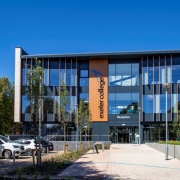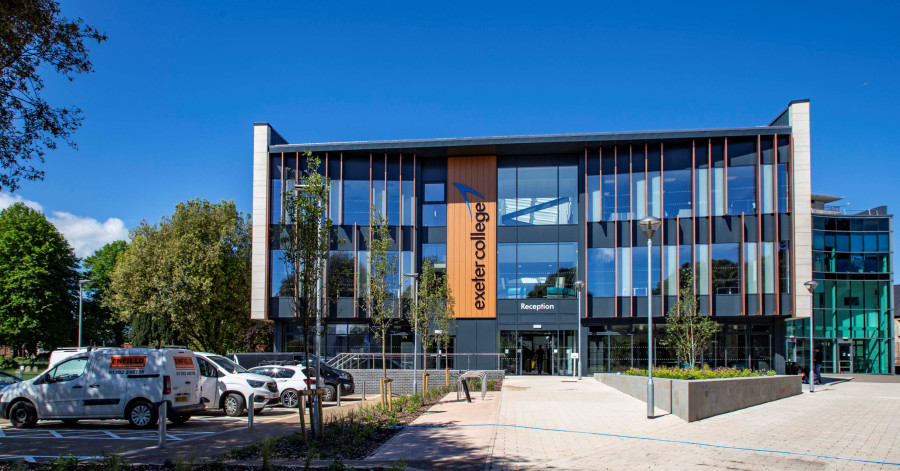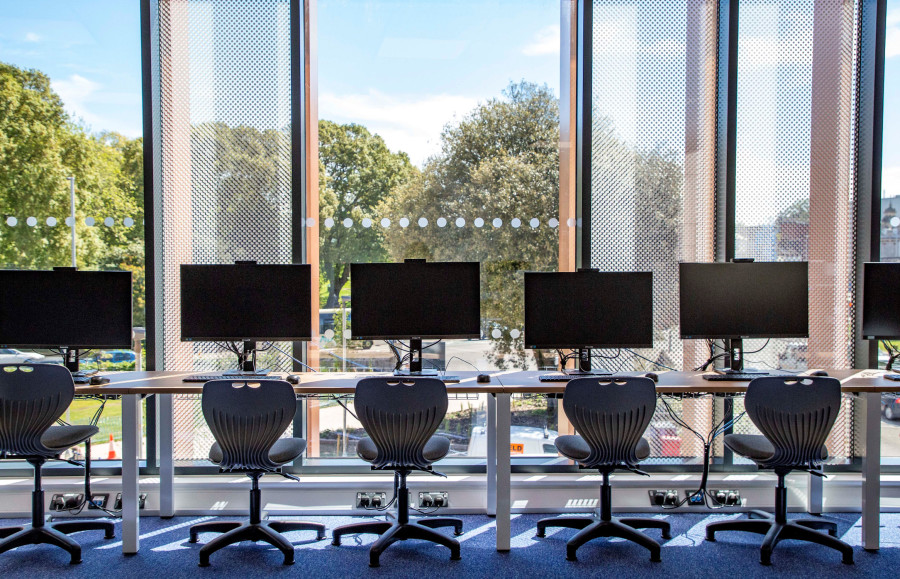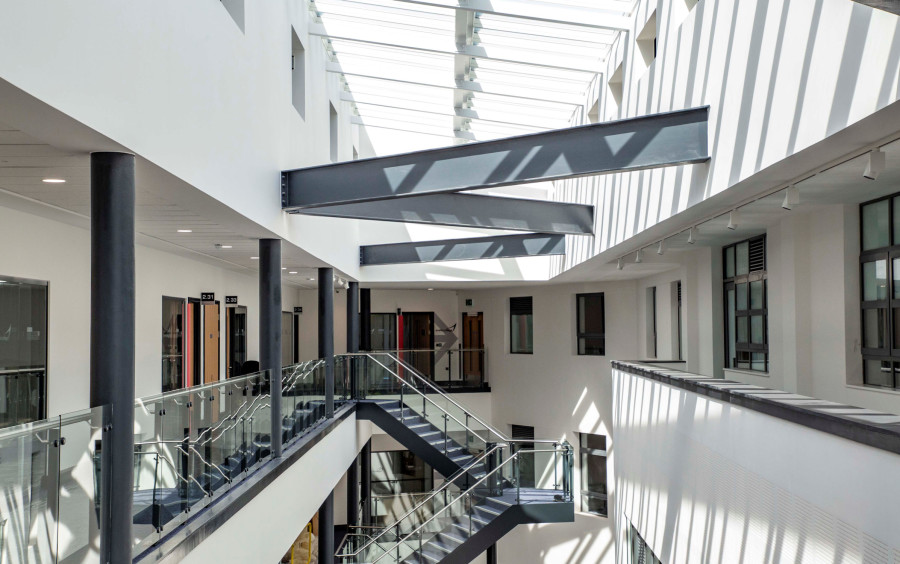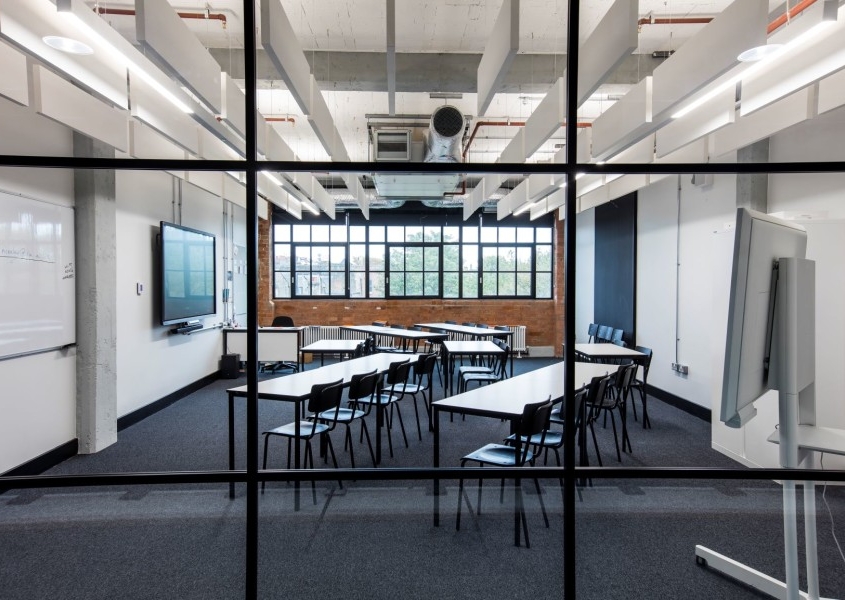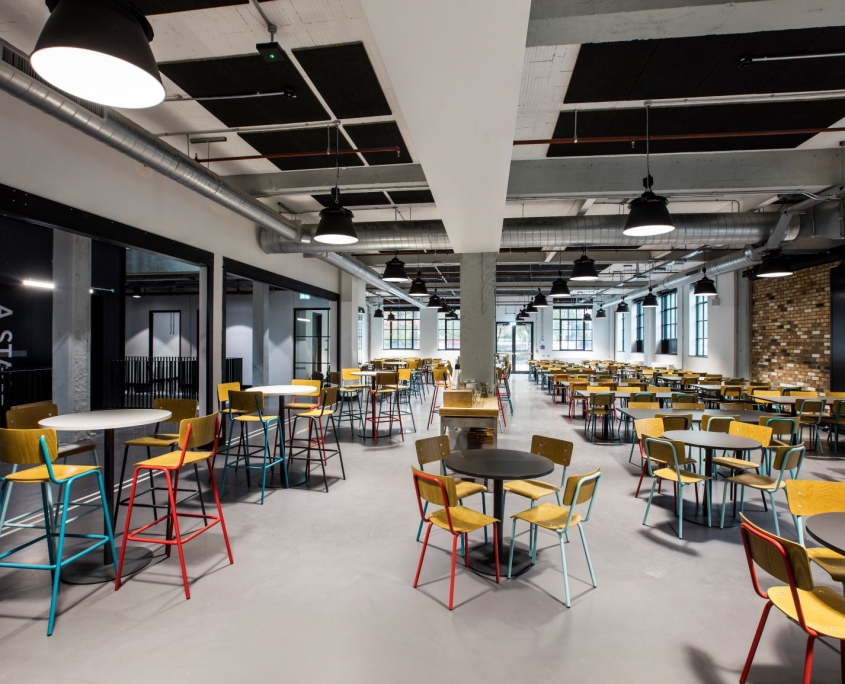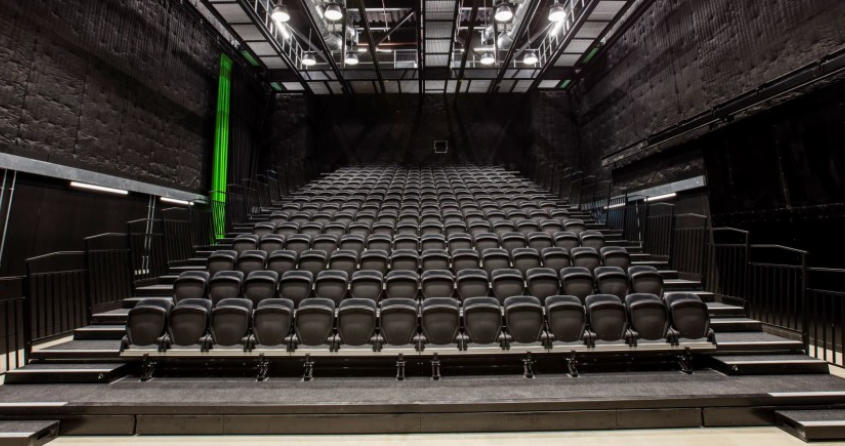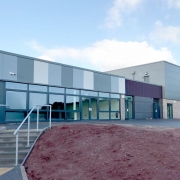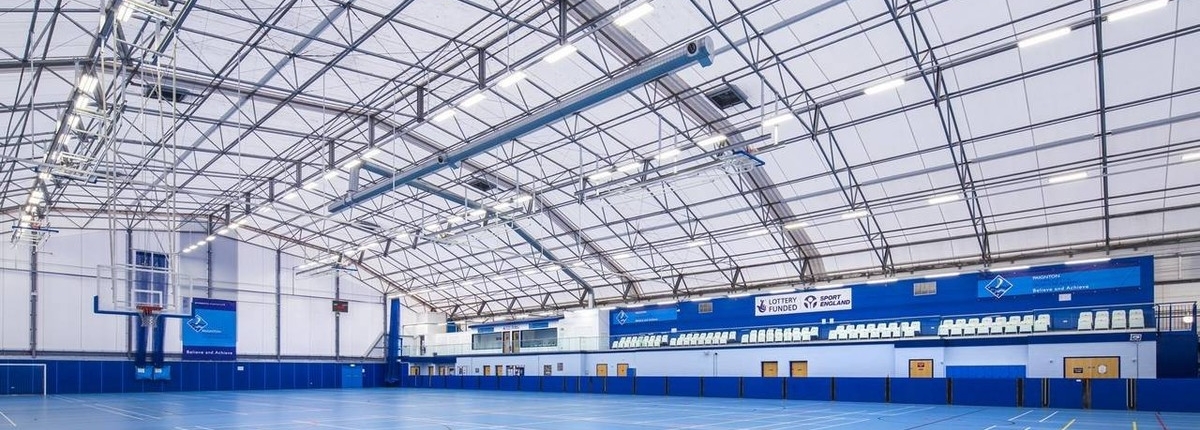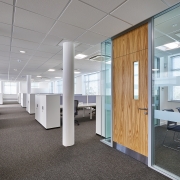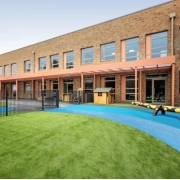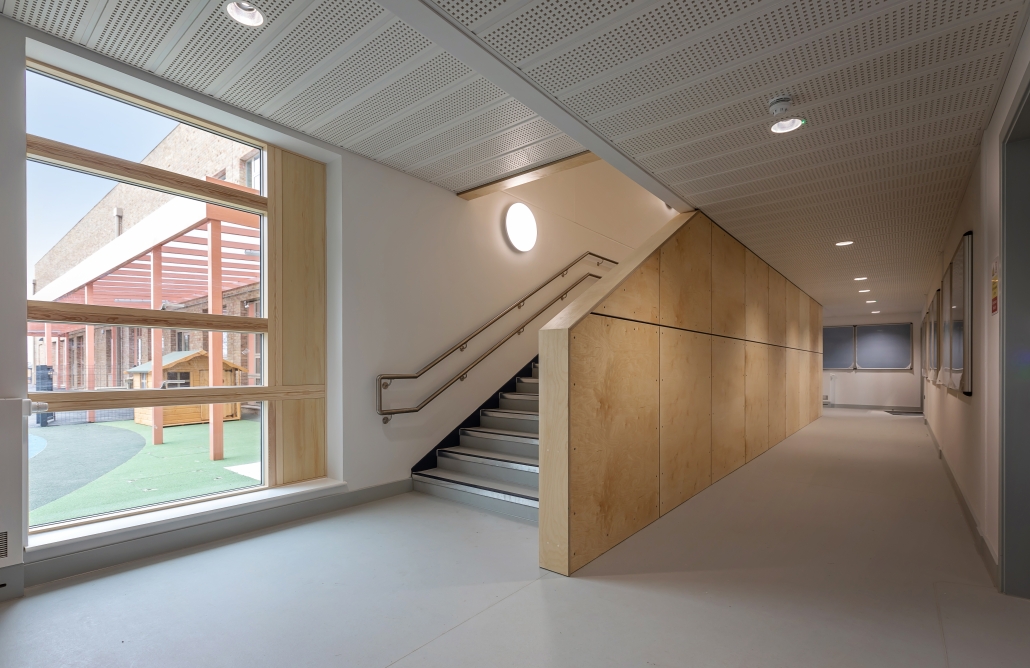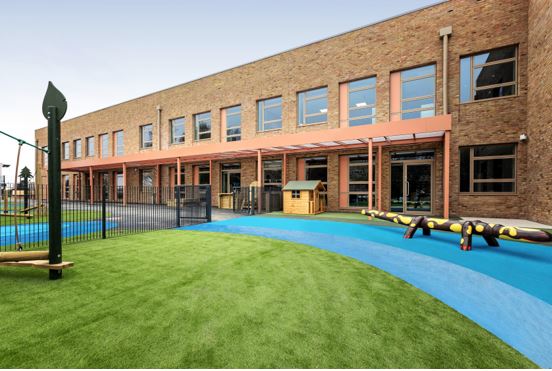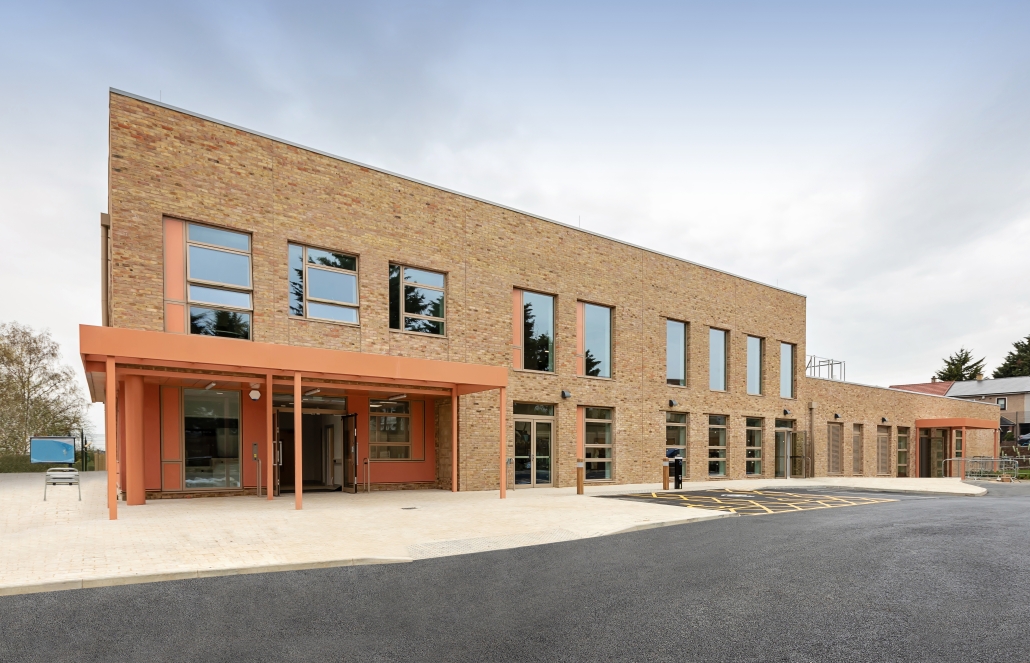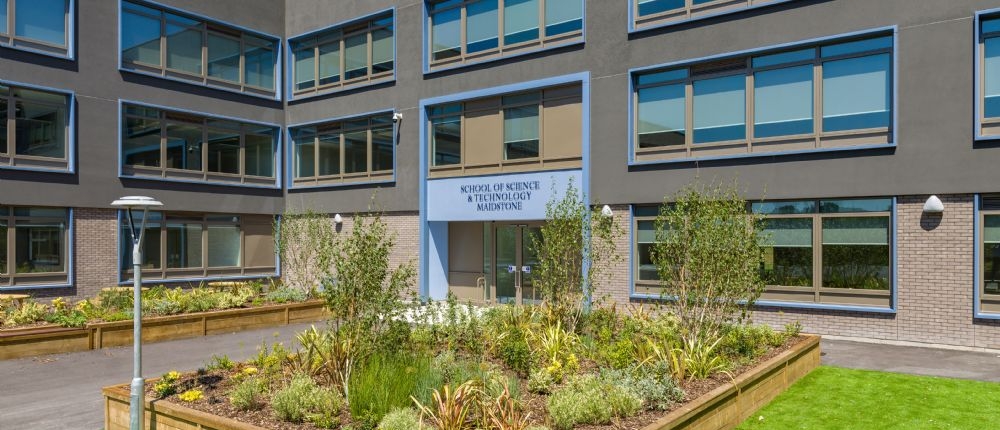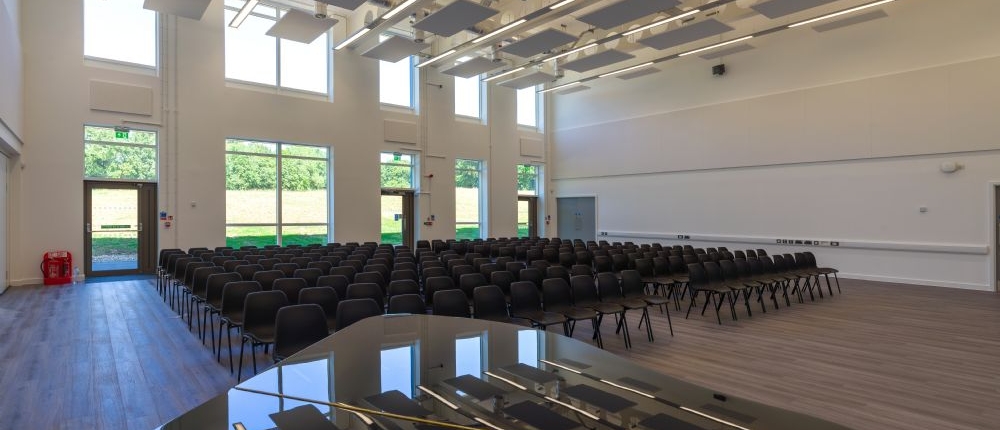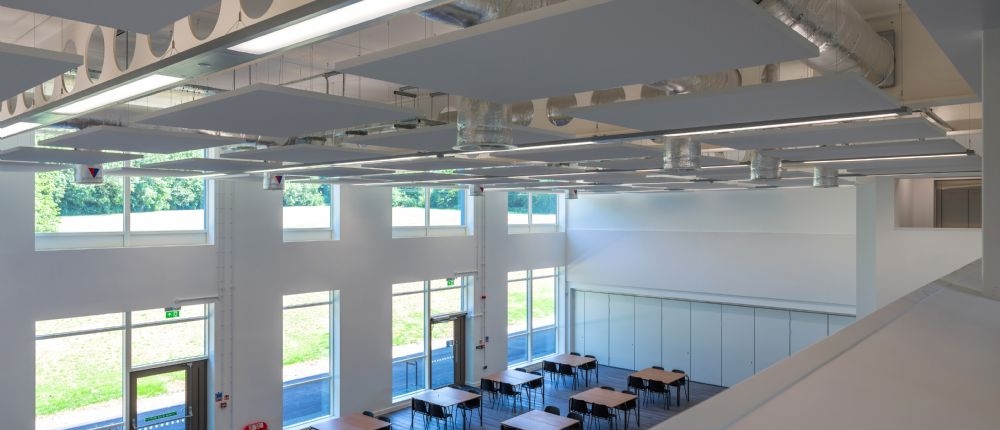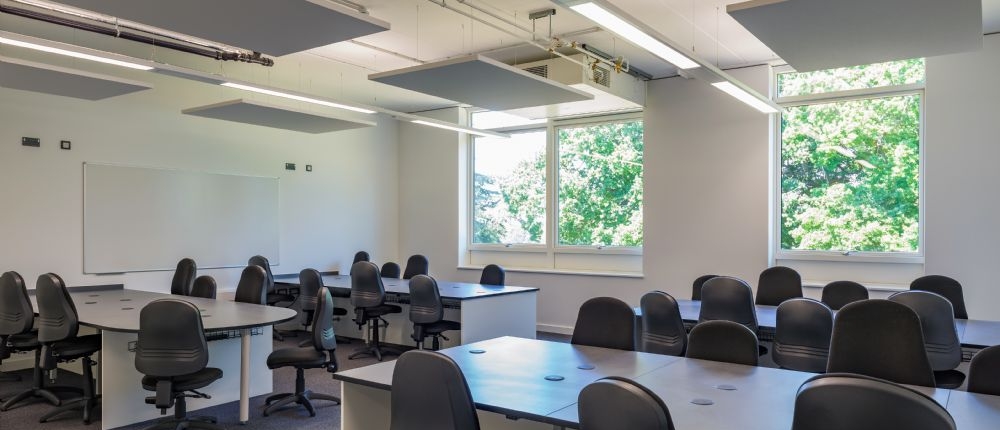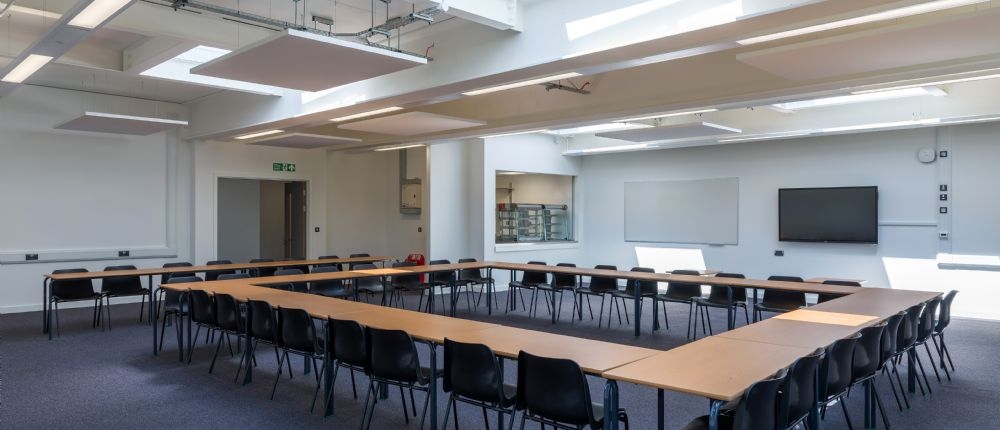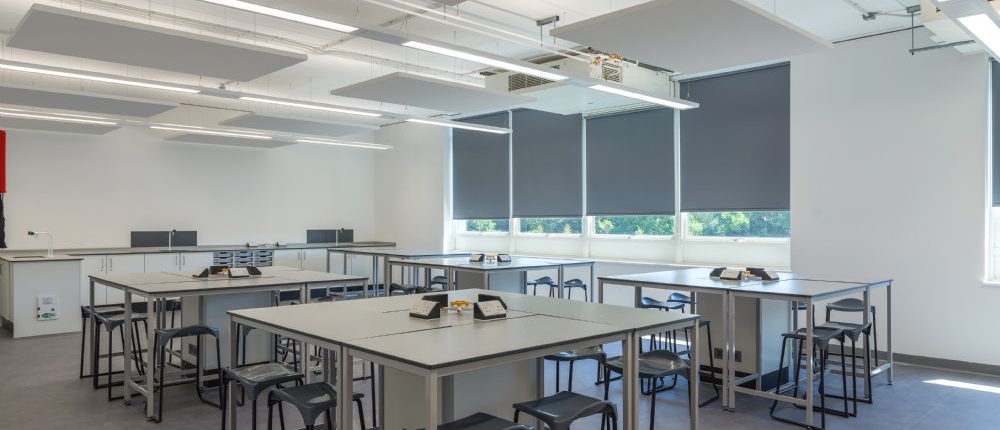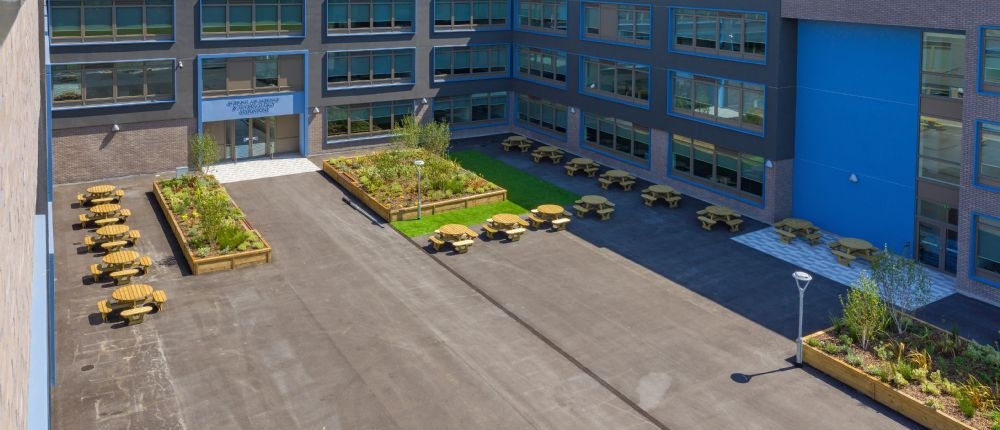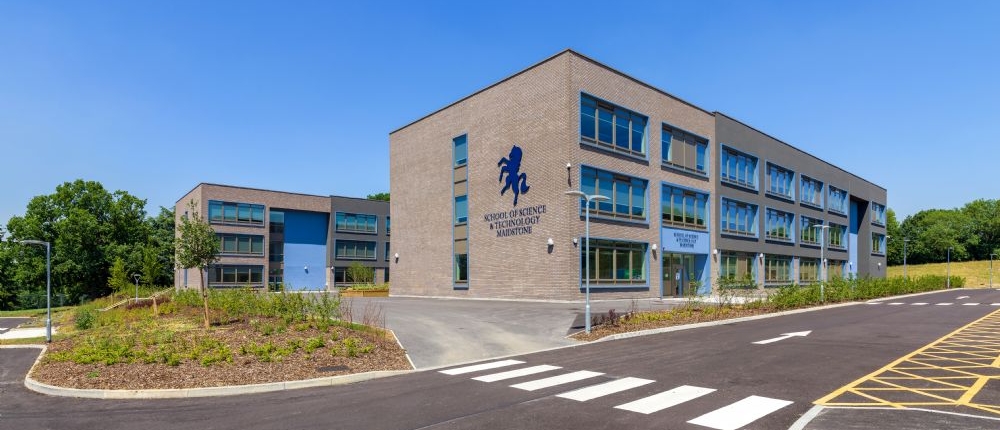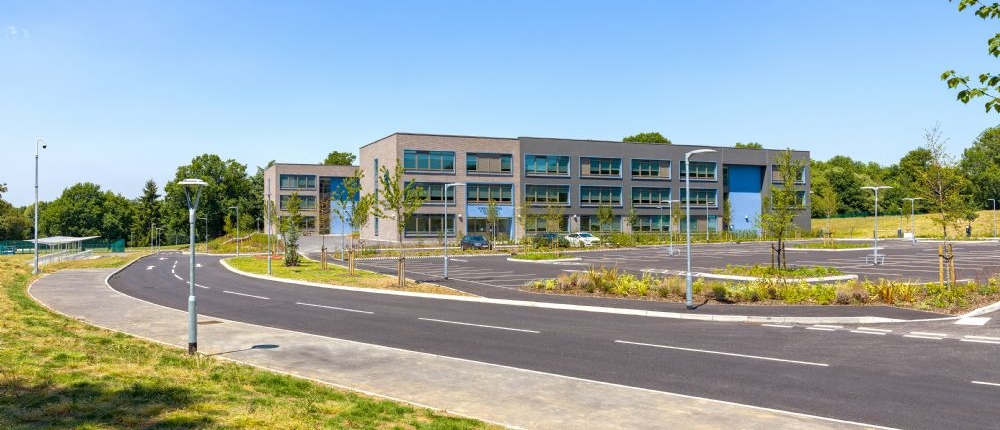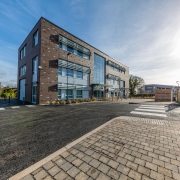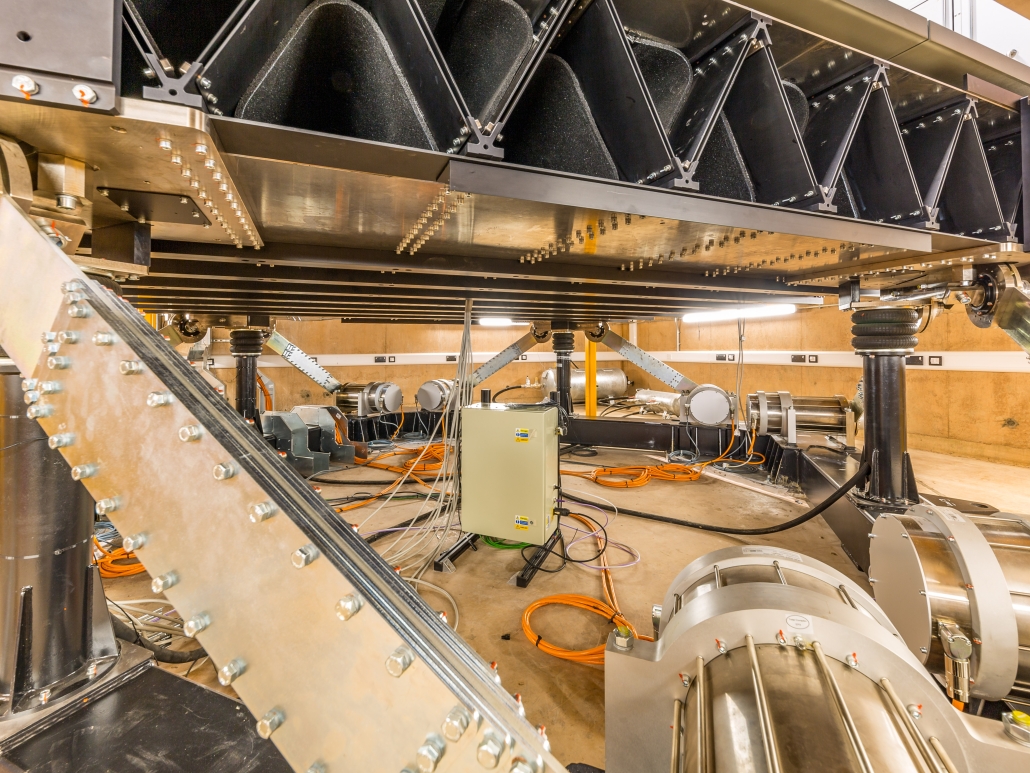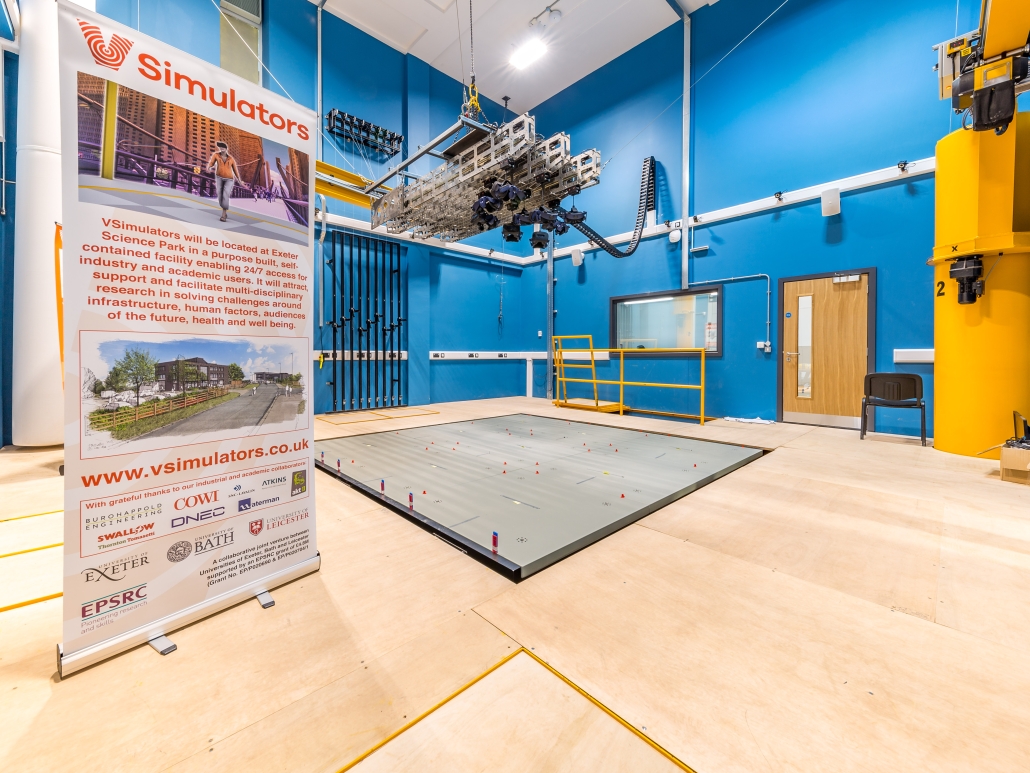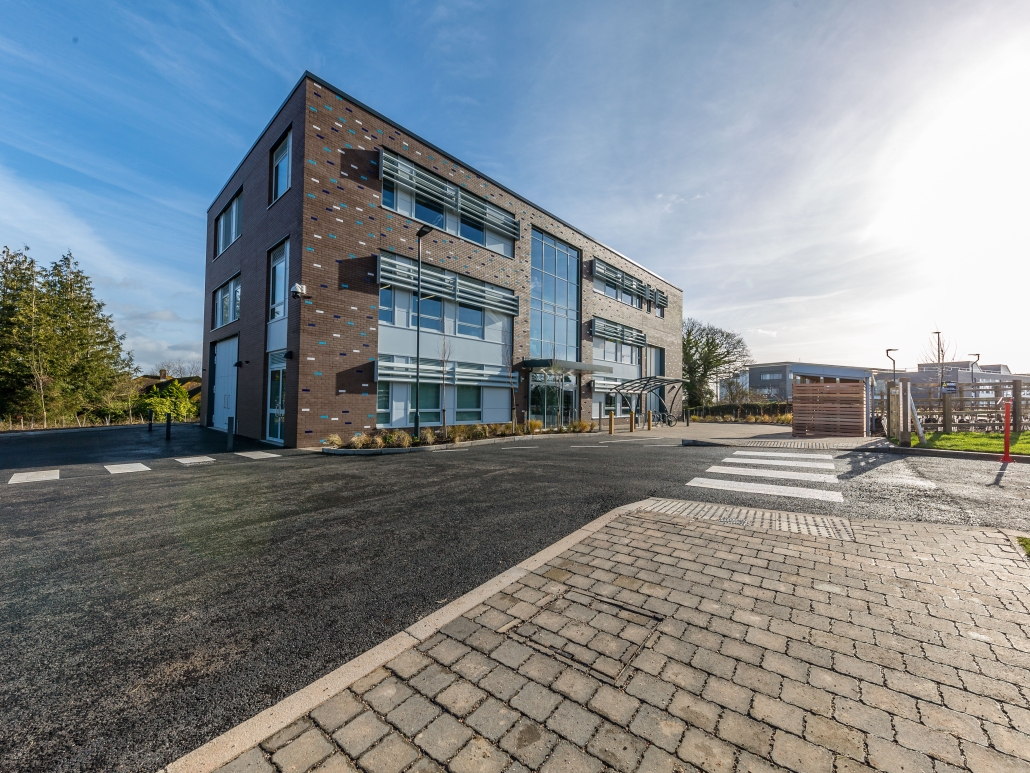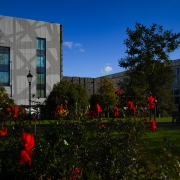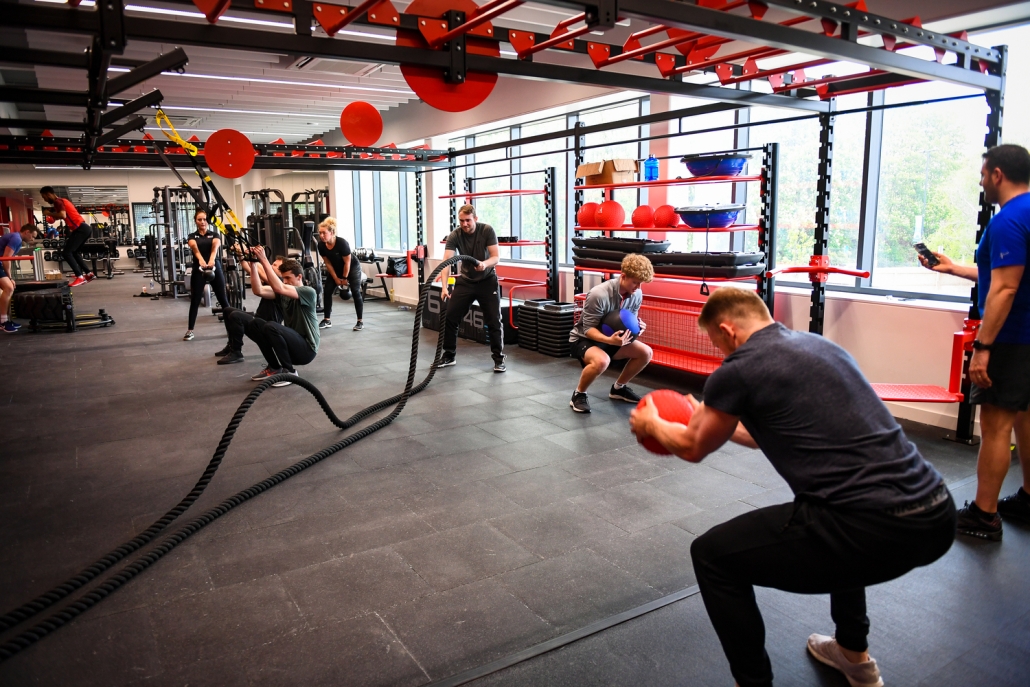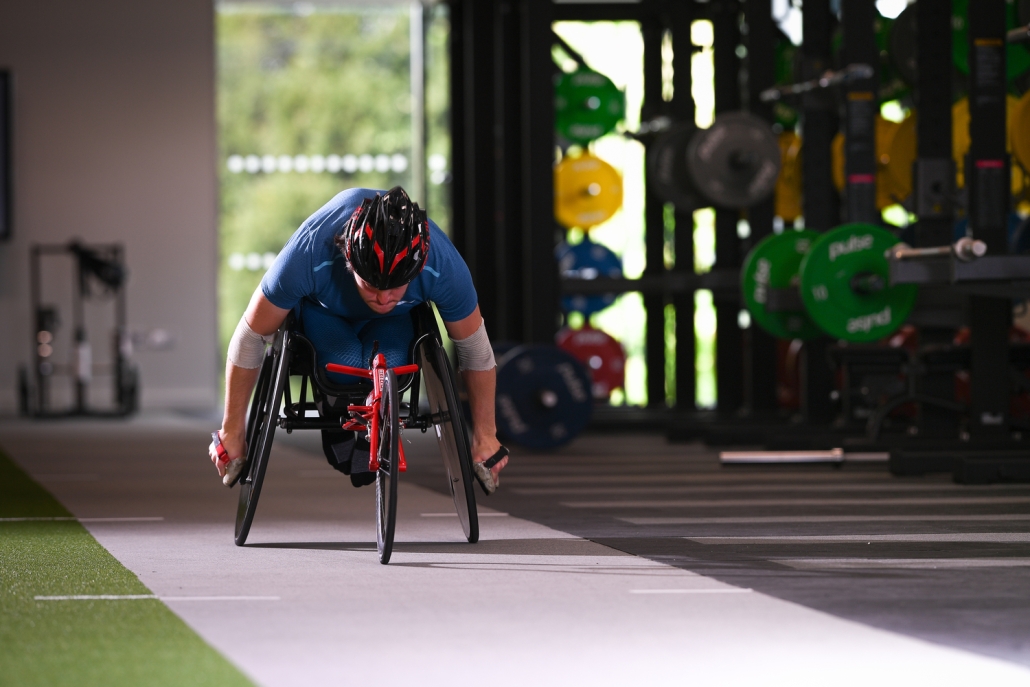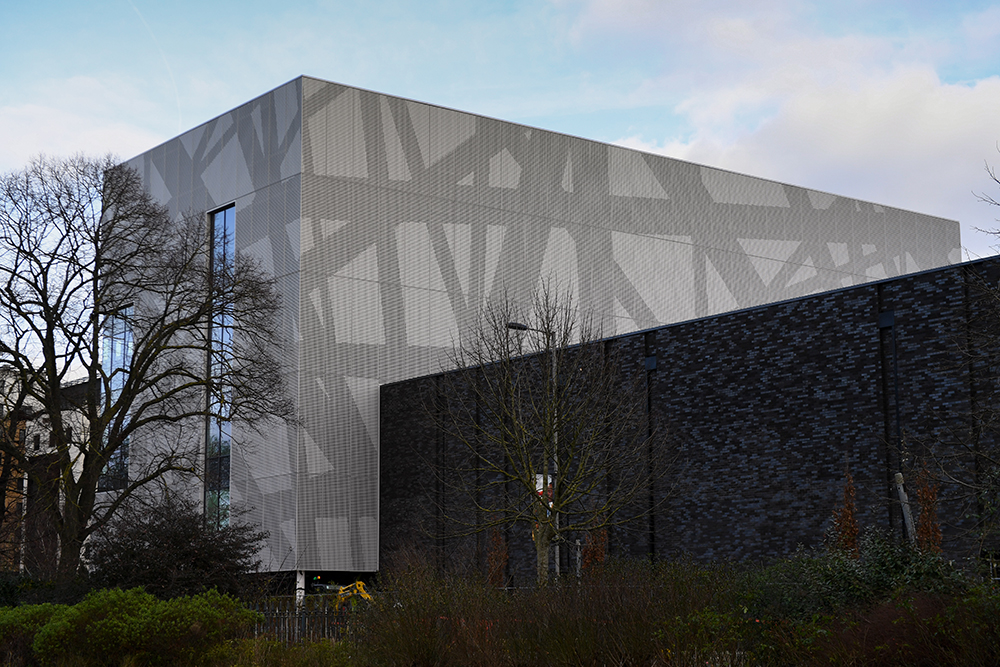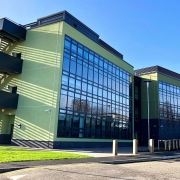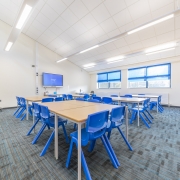Institute of Technology, Exeter College
Project Team
Architects: AWW
Project Manager: SDS
The Challenge
This project was delivered as part of the wider South West Institute of Technology (SWIOT) to allow digital skills to be learnt and developed across the region.
Operating on a tight live city centre campus, the Willmott Dixon team needed to adhere to comprehensive logistic plans to minimise the impact on what is normally a busy campus. Comprising of a steel frame with precast planks, the building features a lecture theatre, triple height atrium space and feature staircase.
The Solution
Approached designed solution with a ‘kit of parts’ having underlying traditional construction. The façade is clad in ceramic rainscreen to mirror and enhance the local architecture. The principal elevation is made up of curtain walling, with bronze brise solei providing passive shading. Willmott Dixon also interfaced with and refurbished the existing ‘Hele Building’ to be a new home for Exeter College T Level syllabus.
The Results
The new building was completed on time and on budget with minimum disruption and the students were able to use this fantastic facility as planned.
The new Digital and Data Centre at Exeter College now provides industry standard facilities which will help plug the digital skills gap in the industry, as well as supporting employers in the region. The centre is a great addition to the local community and interfaces seamlessly with the existing ‘Hele building’ on the college’s Hele Road campus.
Apprentices
SME Spend
Added Value
Client Satisfaction
Contractor Performance | Commitments
Fair
99% fair payments made
Sustainability
Committed to embedding the
principles of sustainable living and development
across the whole scope of activities
Safe
Zero RIDDORs
Legacy
477 professional hours spent supporting local people, Exeter College and local partnerships
Aftercare
Handover & Aftercare Contractor Promise
SCF Framework Manager
Kingsley Clarke
Email: kingsley.clarke@devon.gov.uk
Phone: 07805760622
Contractor Framework Manager
Guy Dawes
Email: Guy.Dawes@willmottdixon.co.uk
Phone: 07989 179444
The London Screen Academy
Islington, London
The Challenge
London Screen Academy was a design & build project which involved the partial demolition of part of the central and southern section of the existing 4 storey plus basement building. The logistics of building within a building was the most challenging aspect of the project
One of the biggest refurbishment challenges to the non-studio part of the project was the sagging and heavily deflected floors that were in the existing building. The beam-and-pot floor construction had been filled with terracotta void formers but over time this has sagged by up to 60mm across the full extent of the floor.
While the structural condition of its primary frame was generally good, there were some wear and tear problems associated with cracked lintels and corroded steel reinforcement helibars within concrete.
The Solution
The refurbishment gives the building a major internal reconfiguration as well as adding a new steel frame structure which provides a three-storey film production studio and supporting facilities. The scope of works also included new windows and façade repairs to the existing building.
The existing 4 storey plus building was replaced with a 3 storey plus basement building and a third floor roof amenity space, provision of replacement doors and windows to include ventilation louvres, reinstatement of door on Highbury Grove frontage; provision of bicycle and bin storage and new fence along Kelvin Road frontage; new glazed roof on single storey extension to the south, and removal of the existing single storey structure on roof, extension of two existing stair cores and lift overrun, and provision of new balustrade, photovoltaic panels and a sedum roof at roof level in order to facilitate the use of the building as a specialist Class D1 sixth form school.
The Results
The former factory in Islington has been transformed into a new specialist sixth form-only free school for 1,000 16 to 19-year-olds, providing training in film and television, with specialist areas including editing suites and music and performance spaces.
The interiors team worked closely with the design team to deliver the project ready for the first intake of 300 students in September 2019, with the LSA expanding eventually to a capacity of 800-1000 pupils.
Apprentices
SME Spend
Added Value
Client Satisfaction
Client Testimonials
Contractor Performance | Commitments
Fair
100% of payments made on time
Sustainability
98% of waste diverted from landfill
A key aspect was a heating system that makes use of passive heat recovery, using outdoor air to cool the building where possible.
Further low carbon technologies include 100% LED lighting throughout the building, with additional daylight dimming functionality and presence detection.
Extensive electricity, water and gas metering was installed and is monitored by the Building Management System (BMS) so that data can be analysed to further optimise energy usage.
The building’s roof has a green area to enhance biodiversity, solar PV panels to generate renewable electricity and export back to the national grid, achieving cost savings, improving occupancy wellbeing and retaining the building’s existing character.
Safe
Legacy
Aftercare
Handover & Aftercare Contractor Promise
SCF Framework Manager
James Wright
Email: james.wright@hants.gov.uk
Phone: 07761 330560
Contractor Framework Manager
Guy Dawes
Email: guy.dawes@willmottdixon.co.uk
Phone: 07989179444
Paignton Community and Sports Academy
Paignton Community and Sports Academy
Paignton, Devon
Project Details
Client
Bay Education Trust
Project Manager
Torbay Development Agency
Architect
KTA Architects Ltd
Contractor
Midas Construction Ltd
Value
£2.4m
Contract Period
38 weeks
Procurement Type
Competitive tender – 2 stage
Form of Contract
JCT Intermediate Building Contract with Contractors Design 2016
Size
880m²
Apprentices
17
Project Brief
Supported by the Torquay Development Agency (TDA) and with capital funding secured via a Condition Improvement Fund from the Education and Skills Funding Agency, this project at Paignton Community and Sports Academy (part of the Bay Education Trust), saw construction of a single-storey, multi-use hall.
Delivered at the Academy’s live Borough Road campus, the new Events Centre provides a flexible working space suitable for a full range of sporting and extracurricular activities. The hall features retractable seating, a mezzanine level and dual-purpose lecture theatre/ performance space. The Centre includes a kitchen and dining area, entrance lobby and reception, and an external covered walkway.
Midas constructed the Events Centre following demolition of an outdated 1930s teaching block, further enhancing the Borough Road campus through groundworks, landscaping and improved car parking.
The project received a customer satisfaction score of 87% in the survey at practical completion.
“I have been at the Academy since 1986 and this has to be the best news I have ever received – it will give the students both now and in the ensuing years access to state of the art facilities.”
Key Challenges
Works took place on a live educational campus
- To manage works close to live school buildings, Midas secured the site with fencing developed a bespoke logistics plan, scheduling deliveries to avoid school drop off and collection times in accordance with the client’s instructions, to ensure access to the academy was not disrupted. The site employed a full time gate controller for the duration of the project; kept access gates closed and locked when not in use; fitted door closers to pedestrian access gates; enforced a one-way vehicle access system; and established a corral at the entry point to get deliveries off the main road. The team and completed all works, loading and unloading within site boundaries only. The Senior Site Manager met frequently with the Academy Head Teacher to discuss relevant aspects of the work, and liaised with the Academy’s Health & Safety Coordinator and caretaker with regard to programming and access.
The Academy took partial occupation of the building during the works
- Partway through the project and in agreement with the client, Midas moved the Academy’s office and canteen facilities to within the new Event Centre. The Midas team positioned pedestrian barriers in the corridors, to prevent unauthorised access and to direct site operatives, with access monitored by Midas and Academy staff. Midas risk assessed all activities with consideration for the proximity to pupils.
Challenging site containing several live services
- During the enabling works, Midas commissioned a ground penetrating radar survey of the site. The team identified routes of live services, using spray paint to colour code manhole covers for service type (blue for storm drains, red for foul drains and a red C for combined drains). Operatives worked under permits to dig and CAT scanned areas prior to excavation works. As the team brought new services onto the site Midas marked them up on service drawings, displayed routes on notice boards and attached to drawings to relevant permits.
Project Takeaways
Our Success
- The client appointed separate contractors to complete fit out works during our project. Midas ensured all operatives received a full site induction prior to accessing live areas of the site and ensured operatives followed site rules and restrictions, avoided restricted areas and followed noise and dust controls stated within the induction and specific risk assessment method statements. The Midas Site Manager controlled the process.
- To bring the works in line with the budget, Midas led a detailed best value review, with £390k of our proposed savings accepted by the client. Amendments included changing the design from three flexible classrooms to a hall, a better provision for the client’s needs; and working closely with the design team to deliver proposed solutions.
- The project successfully diverted 100% of waste from landfill, through measures including crushing and reusing hard materials from the demolished building as a piling mat. To further reduce the project’s carbon footprint and manage the limited parking availability, Midas actively encouraged the use of vehicle sharing, public transport, cycling or walking to site, providing public transport timetables in the site office.
Our Learnings
- The site had limited space for contractor parking, which presented a challenge outside of school holidays when contractors parked in nearby roads. The team implemented parking controls and advised contactors of local restrictions, with the Senior Site Manager delivering toolbox talks on restrictions and briefing contractors that anyone not adhering to site rules would be removed. Vehicles displayed a Midas notice with the Senior Site Manager’s contact information, to ensure any issues could be promptly addressed.
- Working closely with our specialist subcontractors and the client, Midas resolved an issue with availability of high-level cladding panels. With agreement from the client the team implemented a temporary cladding solution, fitting a sacrificial profiled metal cladding, which rapidly waterproofed the building and allowed the site team to progress with internal works. The Senior Site Manager worked closely with the design team and M&E subcontractor to incorporate design changes implemented part way through construction, coordinating services to mitigate potential delays and ensure on-time completion.
Value Added
- £390,000 (16.3% of project value) of savings offered to the client at Gateway 3, with £392,818 (16.4%) of savings delivered at Gateway 4 through a combination of best practice and added value measures. Midas delivered £75,000 of savings by rationalising the size of the kitchen; saved £50,000 through amendments to the cladding specification; and saved £100,000 through rationalisation of rooflines and building footprint.
- The project worked to the Employment and Skills Plan (ESP) and surpassed all agreed targets, hosting five work placements; creating two jobs with the National Skills Academy for Construction; attending 11 Construction Careers Information, Advice & Guidance Events; delivering 98 waged training weeks on site; supporting 18 workforce qualifications; and delivering seven training plans for subcontractors. The Midas Employment & Skills Coordinator and the Academy’s Mentor & Recruitment Manager spoke to approximately 300 students about careers in construction, as part of an assembly. Including those employed by the supply chain, the site supported 17 apprentices.
- The project employed 95.2% small and medium-sized enterprises (SMEs), with 95% of SMEs based within 30 miles of the site.
- The team donated timber offcuts and old pallets to a local scout group; supported the school’s construction curriculum; and Midas sponsored the school’s football kit.
KPI’s & Statistics
Apprentices: 17
Average AIR: 0.7
Average CCS: score 37
Waste diverted from landfill: 100%
Cost/m²: 2,874m2
Cost/m²: excl abnormals 2,189m2
Nuclear Decommissioning Authority, Oxfordshire
Nuclear Decommissioning Authority (NDA)
Didcot, Oxfordshire
Project Details
Client
Nuclear Decommissioning Authority
Project Manager
Avison Young
Architect
Avison Young
Contractor
Morgan Sindall (Overbury)
Value
£2.4m
Contract Period
32 weeks
Procurement Type
Design & Build
Form of Contract
JCT D&B
Size
1600 m2 GIFA
Project Brief
The West elevation of Building 329 was the subject of a CAT B fit out, on the ground floor this will include wings G,H,J & K, cores 2 & 3 and link 2. To the first floor fit out works were to wings J & K and core 3. The existing WC blocks on the ground floor and first floor, although within the site demise, were not the subject of any works.
Overbury took overall responsibility as principal contractor for the whole of the above areas and coordinated their works accordingly with adjacent tenants and the landlord contractors at the east end within building 77.
The floor plates included works to provide open office space complete with office desks and enclosed meeting rooms and offices; new comms and patch rooms to both floors. Existing carpet finishes remained in the majority of areas with new feature carpet to various walkways and offices. Decorations completed to all areas in line with finishes plan. Amendments to services were carried out to align with the new layout and occupancy levels. Kitchenette, and post room provided to the ground floor and a kitchenette to the first floor. Services included Access control, FA, CCTV, Intruder alarms and data to all areas.
The west elevation entrance was altered to accommodate new revolving entrance doors, with extended external paved landing and steps. Internally the entrance was fitted out with security speed lanes, reception desk, visitor WC and security office including ceramic floor tiles throughout.
All external windows had Anti Shatter clear film applied. The north of wing K had a sliding wall installed to provide a large conference room or 2 x smaller seating areas.
Due to the known presence of ACM, this required specialist attendance to accommodate removal of base build structures to facilitate the installation of services and finishes. Fixing of high and low level components were the subject of strict procedures to negate penetrating through the known ACM.
New service and drainage connections and ducting required both external and internal excavations.
Key Challenges
Extent of asbestos remaining within the building
This could not be removed as encased within the base build floor slabs across the entire area. We had to re-sequence all works and re-programme the works to allow the asbestos contractors to “deal” with installing our fixings and provide us with service penetrations before handing the areas back to us following air clearance certificates being issued.
Fixing methods of all components due to asbestos
This encompassed all services, specifically at high level. We achieved this by installing 4000 meters of Uni-Strut to suspend all services and ceilings from it. The Uni-Strut was fixed by our specialist Asbestos Contractor using circa 8000 fixing bolts. Fixing of components to floor was also problematical as limited to depth of fixing so we did not penetrate the Asbestos. Re-designed base units and fixings and depth gauges on drilling tools were used.
Security design and installation extremely sensitive and classified as “Official Sensitive” in all correspondence
This meant that we and our security contractor had to under go security clearance checks, with our security contractor being subjected to extensive checks by the NDA authorities.
Distribution of all security designs and drawings could only be carried out via a specific PC located within NDA premises. Displaying of any designs or drawings could only be done on any floors above 1st floor level, all items had to be removed at the end of the working day and placed under lock and key.
Project Takeaways
Our Success
- Overcoming all of the asbestos related issues and maintaining programme.
- Overcoming all of the security related requirements leading to maintaining an excellent relationship with our client.
- Assisting the client with communications between them and their landlord in resolving getting the LTA ( licence to alter) agreed, we did this as we had a very good relationship with the landlord from a previous fit out for them.
Our Learnings
- The extent of the external excavations became an issue, this was mainly attributed to obtaining information from 3rd parties which took some time. However, once received, we were able to reconsider our methodology and were able to overcome unforeseen issues within programme.
KPI’s & Statistics
| Contract | Gateway 2 Planning | Gateway 3 Contract Agreement | Variation |
|---|---|---|---|
| Cost | £2,105,632 | £2,105,632 | 0% |
| Time | 29 weeks | 31.3 weeks | +2.3 weeks |
Kidbrooke Park Primary School
The epitome of Team Collaboration
- Integrated Team of the Year 2022 – SCF Framework Awards
Appointed by Royal Borough of Greenwich, Galliford Try recently completed a 2 form entry community primary school for 420 primary and 26 nursery pupils, including a Behaviour Support Unit hosting up to 18 children. The works comprised a two-storey building, extensive landscaping and sports facilities served by a standalone changing block, which are used by the local community. In addition to a new multi-use games area (MUGA), there are outside learning areas including a wild meadow orchard, forest skills area, trim trails, horticultural area with raised planters and an amphitheatre. The project achieved BREEAM Excellent by maximising passive techniques to reduce energy consumption and environmental impact.
The Challenge
There were several challenges the team faced. Budget constraints and keeping to programme despite being bookended by Covid and three national lockdowns and consequently material shortages and delay were their biggest.
The Solution
Keeping to budget: By engaging with their supply chain partners early in preconstruction, with an emphasis on added value, improved buildability and thus cost efficiencies and actively identifying alternative materials throughout, Galliford Try were able to provide significant savings on the project. Some included redesigning the ground floor slab to in-situ suspended slab, simplification of the window head brick detail and creating dual site access to optimise sequencing, enabling the building and landscape works simultaneously. Comprehensive surveys and ground investigations prior to Contract Award mitigated risks by preventing abortive designs based on assumptions.
The use of BIM Level 2 even though it was not a project requirement reduced both design and installation inefficiencies, saving time and money.
On time delivery: In addition to placing orders early and using more readily available materials to compensate manufacturing shortfalls in the UK and abroad, Galliford Try replaced in-person site visits with Zoom, GoPro cameras and drones for client and end user progress updates and inspections when Covid restrictions and lockdowns were in place.
The Results
The school was completed eight weeks early despite the challenges faced with the additional pressures of three national lockdowns, social distancing and reduced productivity (less people on site and delayed materials). The team achieved an overall client satisfaction of 9/10, with 10/10 in time management and Health & Safety.
Apprentices
SME Spend
Added Value
Client Satisfaction
Client Testimonials
Contractor Performance | Commitments
Fair
Payment timescales to all: supply chain and manufactures were agreed and adhered to throughout the project. Payment notices were issued on time with zero ‘pay-less’ notice and 97% of subcontractor final accounts were agreed within two months on Practical Completion.
Aftercare
The project and site manager stayed on site four weeks post project completion and continue to keep in touch with the school, in conjunction with our Aftercare team.
To compliment the Aftercare team’s collaborative workshop to the end users 12 weeks prior to completion, the project team completed several site tours with the school’s executives and headteacher during the final construction phase, where defect sheets were presented, and reporting procedures explained during the walkabouts.
Safe
The team achieved AFR ratio 0 and zero RIDDOR, had an average CCS score of 42 and was able to continue to operate safely during Covid with no major outbreaks. The site was awarded ‘Quarterly Safety Award’ twice.
Sustainability
Designed to achieve BREEAM Excellent and with that included details that maximised passive techniques to reduce energy consumption and environmental impacts. Additional features incorporated a highly insulated building envelope, high thermal mass for night cooling, ventilation stacks with heat recovery, 90sqm of solar panels and electric charging points. Acoustic ceiling and breathing building units were installed in classrooms to enhance air quality for better student learning environment and achieved A for energy performance.
Following some tree removal, we reused the logs to form the forest trail and created pathways around the site using mulch (shredded trees). The mulch provided a more stable ground to work on, as well as acting as a nutrient bed for plants.
Legacy
Employment Skills Plan: 68no of apprentices, 4no of employees who were previously unemployed, 5no careers, curriculum and literacy talks and 8 hours of improving staff wellbeing sessions. Covid-19 prevented us achieving our targets in full during the construction phase. In agreement with Royal Borough of Greenwich, we delivered our promises post project completion.
Greenwich’s own: A labourer, gateperson and welfare labourer/cleaner were employed through Greenwich council’s employment scheme, Greenwich Local Labour and Business.
Looking after the smaller businesses: To encourage greater micro and VCSE participation, we held a Meet the Buyer event at Greenwich Town Hall. To ensure that they could work with us and other contractors in the future, we held individual workshops and supported them by completing minimum requirements like PAS91 and Builder’s Profile registration.
Greater emphasis on health and wellbeing: During the early stages of the pandemic, we arranged for a top medical visitor to deliver a toolbox talk to explain Covid 19 and ‘debunking some of the myths’ surrounding the illness. Not only did this reassure our operatives, but also provided them the opportunity to ask questions and have first-hand information affecting both theirs and their families’ health.
Lasting school legacy: We donated a mosaic plaque with the school’s crest at part of the Opening Ceremony.
SCF Framework Manager
James Wright
Email: james.wright@hants.gov.uk
Phone: : 07761 330560
Contractor Framework Manager
Angela Purse
Email: Angela.Purse@gallifordtry.co.uk
Phone: 07593 561855
School of Science & Technology Maidstone
School of Science & Technology
Maidstone, Kent
Project Details
Client
Valley Invicta Academies Trust
Project Manager
Arcadis
Architect
KSS
Contractor
BAM Construction
Value
£25.54 million
Contract Period
93 weeks
Procurement Type
Design & Build
Form of Contract
JCT 2017
Apprentices
12
Project Summary
BAM has built a new secondary school for pupils aged between 11 and 18, with an annual intake of 180 pupils. The school will help Kent County Council to meet the predicted shortfall in secondary places in the Maidstone area.
The curriculum offers world-class teaching and learning with a focus on Science, Technology, Engineering and Mathematics (STEM subjects). The school’s industry partners include Maidstone and Tunbridge Wells NHS Trust, and international educational partner, the School of Science and Technology in Singapore.
“We have worked tirelessly and in good faith throughout the process to develop a school that will provide genuine excitement to those parents in our community.”
Community Engagement
Student Support
- Our Education & Community Coordinator represented BAM Construction at a Kent Local Choices event for students from the local area who are risk of becoming NEET. She also supported Year 10 careers event at Longfield Academy for students within the trust, and delivered two STEM workshops for Year 9 and 10 students at Invicta Grammar School.
- Workshops were delivered to Year 10 students from St Augustine Academy.
- We delivered careers workshops for Year 8 students linking STEM to careers.
- Students from West Kent YMCA – Horizon Project visited site.
- Students from Maplesden Noakes School were given a guided tour around site.
Career Development
- Royal Engineers from nearby Chatham barracks visited site as part of their professional qualifications, one of which undertook a six week placement onsite and gained a greater understanding in how things are actually built and the temporary works required to allow it to happen.
- Wood has been recycled through Community Wood Recycling Social Enterprise helping local residents into training and employment.
- These has been 16 work placements from local schools and colleges.
- Plumbing students from East Kent College visited site.
Key Challenges
Local Transport Links
Maidstone Borough Council were imposing a number of conditions, including significant development of local transport links. Some initial concerns were raised by residents about the potential impact on queuing traffic around the entrance of the school. This was addressed by creating a large drop off zone within the car park area.
Planning
The team worked tirelessly to get the scheme through a challenging planning process. Early contractor appointment was essential to ensure affordable design prior to planning submission. The team have worked hard to achieve this ahead of planning.
Contact: Darren Birch, Framework Manager
Email: dbirch@bam.co.uk
Exeter Science Park – Engineering Building
A bespoke ‘BREEAM Excellent’, 3-storey engineering and research building, housing the world-leading VSimulator facility, providing specialist engineering facilities and open-plan, flexible workspace. The facility will play a major role in spearheading Exeter Science Park’s aspirations and reputation for research and innovation, stimulating a knowledge-based economy, delivering jobs, higher productivity and economic growth.
Providing unique simulation capabilities far beyond anything available worldwide, the VSimulator facility will be used by academics and industry to support multi-disciplinary research factors. Helping to address critical issues of human engagement with the surrounding environment, it will present research, commercial and training opportunities within an endless range of disciplines.
The Challenge
Imperative to the successful project outcome, the Virtual Simulation Chamber had to be handed over to the specialist engineers on time to commence installation of the state-of-the-art motion platform and other equipment.
Additionally, the basement concrete floor had to be within a 2mm-tolerance level and strict water-proofing specifications had to be achieved prior to the VSimulator installation.
Further adding to the challenge were complex logistics and mechanical and electrical installations, and the involvement of multiple, including global, specialist installers.
The Solution
Through sectional completion (in October 2019), we handed over the basement to the University for fitting-out of the simulator, whilst the remaining works continued. We worked closely with the University throughout the fit-out works, ensuring this was undertaken safely while the remaining works took place concurrently.
During early design collaboration, we were able to offer our experience with basement construction to align buildable-construction details with specialist tanking manufactured products. It was at this early stage when a significant change in tanking membrane manufacturers occurred and, with the help of our supply chain family, we were able to provide a quick solution to the benefit of the client.
–
The Results
Communication was critical to ensuring we kept to programme, and we successfully managed the co-ordination of overseas meetings, held virtually, regarding set-up, installation and delivery of equipment for the motion platform.
Drawing upon the expertise and skills of the project team, the challenging project objectives were all achieved, to the delight of the client.
Apprentices
SME Spend
Added Value
Client Satisfaction
Client Testimonials
Contractor Performance | Commitments
Fair
100% payment within 30 days terms
Sustainability
BREEAM Excellent
99% waste diverted from landfill
100% timber responsibly sourced
Safe
Zero RIDDORs
CCS Score 43/45
Legacy
38 No of SMEs
10 beneficiaries
4 jobs created
49 trainee weeks
Schools engagement: 28 students
£200 donations to charity
39 volunteer hours
88% social value created
Aftercare
Soft landings for handover
Dedicated Morgan Sindall point of contact
On-line portal for notifying any defects with 3 priority categories for response times
SCF Framework Manager
Kingsley Clarke
Email: kingsley.clarke@devon.gov.uk
Phone: 07805760622
Contractor Framework Manager
Alan Smedley
Email: alan.smedley@morgansindall.com
Phone: 07967 686066
Solent University Sports Complex
A new build four-storey steel frame building which includes two sports halls, three fitness studios, a health and well-being gym, a strength and conditioning high-performance gym and high-quality teaching facilities on a live university campus. The scheme also includes underground car parking.
The Challenge
The ambitious vision for the University was to create a new sports facility to improve and modernise the University’s offering and enable excellence in sport, health and fitness related degree programmes and associated teaching and research for staff, students and the local community.
The Solution
The seminar and gym areas of the sports complex are fitted with 20mm soft joints between the room floor slabs. These help to isolate them and significantly reduce the vibration that passes through them. In the weight training area, they went a step further and introduced a cast in-situ reinforced concrete sprung floor. This innovation means that the sports hall can be enjoyed by everyone, no matter what activity they are involved in.
The iconic cladding system to the tower block represents the former use of the site with historical maps – a subtle presence in the perforation in the cladding system next to the standout face brickwork wrapping the sports halls. The building has provided a head turning modern build in Southampton’s old city centre.
The Results
The city centre project was constructed within a 86 week programme, delivering a four-storey sports complex with state-of-the-art gyms for both student and staff use. Along the stacked tower block of gyms and studios, the project had two full sized sports halls; one for multi-use catering for over 13 different sports, the other was dedicated to basketball, allowing Student Kestrels, the university’s leading sports team, a home court. Below the sports halls, basement parking was provided for staff, students and the public as well as accessible parking bays.
The project is a visually stunning, flagship sports facility which is enhancing Solent University’s offering in advanced sports degree courses, and it is already attracting more students to the local area and inspiring people to take part in sport.
Apprentices
SME Spend
Added Value
Client Satisfaction
Client Testimonials
Contractor Performance | Commitments
Fair
100% payment within 30 days terms
Sustainability
99% waste diverted from landfill
100% timber responsibly sourced
Safe
Zero RIDDORs
CCS Score 44/45
Legacy
36 No of SMEs
59 beneficiaries
18 jobs created & 184 trainee weeks
Schools’ engagement: 577 students
£3,046 donations to charity & 1,845 volunteer hours
84% social value created
Aftercare
Soft landings for handover
Dedicated Morgan Sindall point of contact
On-line portal for notifying any defects with
3 priority categories for response times
Solent received the University Bronze Charter Mark award from England Athletics, one of only 6 universities to receive a charter mark award to date.
&
Construction News Award 2020 – Community Engagement Project of the Year
SCF Framework Manager
James Wright
Email: james.wright@hants.gov.uk
Phone: : 07761 330560
Contractor Framework Manager
Alan Smedley
Email: alan.smedley@morgansindall.com
Phone: 07967 686066
Science and Engineering Research Support Facility (SERSF)
Science and Engineering Research Support Facility (SERSF)
Penryn, Cornwall
Project Details
Client
University of Exeter
Architect
Stride Treglown
Contractor
Kier Construction
Value
£8.2m
Contract Period
December 2017 – February 2019
Form of Contract
NEC Option A with design
Project Brief
The design and construction of two buildings for laboratories and research facilities to allow further growth of Exeter Business School, the College of Engineering, Mathematics and Physical Sciences and the College of Life and Environmental Services.
This new Science Engineering Research Support Facility (SERSF) building provides facilities for around 200 researchers and postgraduate students specialising in science and engineering.
The new facility accommodates many disciplines, including the newly established Business School, the Centre for Ecology and Conservation, Renewable Energy and Camborne School of Mines. It is also the new home for Law, Energy Policy and Mathematics
A large glazed atrium forms the main entrance and the vertical circulation route to all floors. The installation of a key operated lift allows lab users to access the autoclave area on the lower ground floor which creates a link for users to transport any contaminated waste, safely through the building.
A new seminar facility provides space to facilitate linkage with external agency researchers in marine science and wildlife research.
“As with previous investments at the campus, the aim is to grow the economy of Cornwall and the Isles of Scilly, creating jobs and wealth by building on existing education and research assets, and supporting the development of high-value businesses, people, knowledge, investment and research.”
Key Challenges
Previously constructed buildings.
The project consists of three linked buildings. The first phase of the project had already been constructed, which made the construction of the next two phases more complex as we were connecting and linking floor levels.
Existing services and diversions on main vehicular route.
The site was riddled with existing services and diversions impacted the main vehicular route into the campus. These works were brought forward in an enabling package at a more convenient, less disruptive time for the university.
Project Takeaways
Our Success
- Monthly visits were held for the client along with tours around the building at key milestones of the project. Kier also facilitated open door events which proved successful, schools and University departments attended the events.
- The building includes a large proportion of office space as well as laboratory spaces designed and built to an ACDP Category 2 and five separate controlled environment rooms. Parameters such as temperature, humidity and light can be altered to create real-life environments. Extra over to a typical scheme, SERSF 2 & 3 services includes Gas, Domestic Services, Deionised Water, Lab gases – CO2 & compressed air, Ventilation, Fume extract, Cooling – chilled water, DX cooling, Controls, Above ground drainage (incl lab drainage
Our Learnings
- Due to the sensitivity of working on a live environment, thorough logistical planning was put into place and reviewed weekly.
- The building is naturally ventilated, wherever possible, to reduce the energy load. The laboratory spaces are mechanically vented to achieve the highest standard CL2 environment. Of the 5 temperature controlled rooms, 3 are APHA licenced – meaning air locks and extra security protocols were required.
Value Added
- The project achieved a BREEAM ‘Excellent’ rating.
Court Fields School Extension
Court Fields School
Wellington, Somerset
Project Details
Client
Somerset County Council
Contractor
Morgan Sindall
Value
£736k
Contract Period
32 weeks
Project Brief
Expansion of the existing primary school with the addition of three new classrooms using the ‘Class Space’ standard design. The classroom extension included toilets and was situated on the old basketball court, north of the school’s sports hall.
The client wanted the classrooms to be flexible for potential future use and expansion. Therefore, the internal dividing walls were stud work and the school’s preferred option of radiators were used instead of underfloor heating. The position and orientation of the building on the basketball court area were carefully designed so the school could construct another block adjacent to this one in the future. Other considerations included design items, such as mains cable sizes.
The extension was constructed of steel frame, blockwork rendered externally, with a profiled metal roofing system.
“With pressure already on our existing primary schools, this will help to ease some of that and it is in all of our interests to make sure that any new school provides the very best education for those children.”
“Morgan Sindall achieved practical completion in accordance with school autumn term opening requirement. This included providing access for Somerset County Council and the school for FFE works.”
Project Competencies
Fair
Fair Payment Charter
Sustainable
Sustainable Development Charter
- Thermal insulation improved with revised roof specification reducing operating cost for client
Safe
Health & Safety Charter
- Zero RIDDORs
Legacy
Legacy Charter
- Site visits offered to any pupils interested in a career in construction
Aftercare
Handover & Aftercare Contractor Promise
Community Engagement
Careers Opportunities
- The school were approached to offer site visits for any pupils interested in a career in construction
- Virtual work experience provided during February Half term
Key Challenges
Maintaining the school’s curriculum while working in a live school environment
- We regularly liaised with the school on any specialist activities, such as crane lifting. School holidays were targeted to carry out potentially disruptive tasks, such as removal of soil from site with multiple lorry movements.
Ensuring business continued as normal while coordinating deliveries
- Access for deliveries were planned during off-peak times and larger deliveries diverted to an alternative entrance at the rear, where necessary. Daily communication was undertaken with the school to keep them updated on deliveries and any changes to planned activities. Any disruptive works, such as the removal of soil from the site which required multiple lorry movements were planned during school holidays.
Ensuring the design allowed for future use and expansion
- The internal dividing walls were studwork and radiators used instead of underfloor heating. The position and orientation of the building on the basketball courts area, were carefully designed to allow an addition of another block in the future. Other consideration were also made when designing items, such as mains cable sizes etc., again for possible future expansion.
Project Takeaways
Our Success
- Through early involvement during the preconstruction stage we were able to undertake surveys of ground conditions and services to minimise unknowns and provide cost
assurance. - Excellent health and safety maintained within a live school environment with full secure site boundary, scheduling movement of vehicles during off-peak times and utilising
school holidays for potentially disruptive works. - Completion on-time, ready for the Autumn term and flexibility of the site team allowed Somerset County Council and the school to access the building for FF&E and fit-out.
Our Learnings
- The project was a D&B with limited collaboration required, however the project still required a regular flow of communication throughout the preconstruction and
construction phase to all parties
Value Added
- During the course of the project we value engineered specific products to provide a cost time benefit to the client whilst also increasing thermal efficiency and reducing Whole Life Costs. Various elements were looked at to bring overall costs down such as changing the roof and insulation. For the Whole life Costing, thermal insulation was improved with the revised roof specification which provided reduced operating cost for the client.
KPI’s & Statistics
| Contract | Gateway 2 Planning | Gateway 3 Contract Agreement | Variation |
| Cost | £2,462k | £2,417k | -1/8% |
| Time | 32 weeks | 32 weeks | 0 |
Contact: Alan Smedley, Framework Manager
Email: alan.smedley@morgansindall.com
